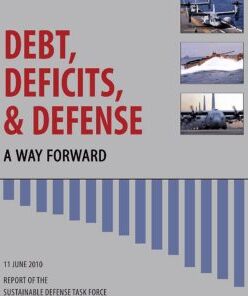Budget
Panel: Debt, Deficits, and Defense — Report of the Sustainable Defense Task Force
Debt, Deficits, and Defense: A Way Forward
Report of the Sustainable Defense Task Force, 11 June 2010. ➪ PDF ➪ summary PDF
The Dynamics of Defense Budget Growth, 1998-2011

by Carl Conetta, May 2010. ➪ PDF
Prepared for “Economics and Security: Resourcing National Priorities,” a workshop sponsored by the William B. Ruger Chair of National Security Economics, Naval War College, Newport, Rhode Island, May 2010. This article also is a chapter in Richmond M. Lloyd, ed, Economics and Security: Resourcing National Priorities (Newport RI: Naval War College, 2010).
- A related PDA publication of interest: An Undisciplined Defense: Understanding the $2 Trillion Surge in US Defense Spending, 18 January 2010, with 21 charts & tables.
Get Serious About Reform: Budget Challenges Will Force Hard Choices
The President’s Dilemma: Debt, Deficits, and Defense Spending
An Undisciplined Defense: Understanding the $2 Trillion Surge in US Defense Spending
Report of the Task Force on a Unified Security Budget for the United States, FY 2010
Toward a Sustainable US Defense Posture: An Option to save $60+ Billion Over Five Years
Unified Security Budget for the United States, FY2008
America speaks out: Is the United States spending too much on defense?
Experts give poor grades to expected defense budget proposal
Report of the task force on a Unified Security Budget for the United States, FY2007
Our Indefensible National Security Budget
Die Europäische Union: Stolpersteine auf dem Weg zur Integration (The European Union: Stumbling Blocks on the Road to Integration)
Fighting On All Fronts
‘Something Has to Give’ in Pentagon Spending
QDR 2006: Do The Forces Match the Missions? DOD Gives Little Reason to Believe
Terrorism, World Order, and Cooperative Security: A research and policy development agenda
Bigger Budgets Will Not Cure the Pentagon’s Ills
Can the United States Spend Less on Defense? — Toward a Smaller, More Efficient, and More Relevant US Military
Europe’s Armed Forces at the Millennium: A Case Study of Change in France, the United Kingdom, and Germany
The Readiness Crisis of the U.S. Air Force: A Review and Diagnosis
Defense Sufficiency and Cooperation: A US Military Posture for the post-Cold War Era
Wanting Leadership: Public Opinion on Defense Spending
Post-Cold War US Military Expenditure in the Context of World Spending Trends
by Carl Conetta and Charles Knight, PDA Briefing Memo #10, January 1997.
➪ HTML
➪ summary
Based on a review of official world military spending data, this study finds evidence that the strategic position of the US and its allies has improved immensely relative to the potential threat states. It also looks at regional trends and offers a perspective on the new and ambitious regional military strategy of the U.S.
Build-Down: US Armed Forces Retrenchment in the Context of Modernization
➪ HTML
A detailed examination of how current military modernization programs will interact with planned force reductions in shaping America’s future armed forces. The report looks beyond superficial indicators of change to suggest the real, net effect of the current policy on the nation’s military capability.

